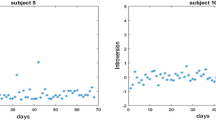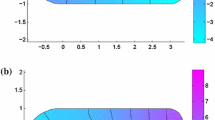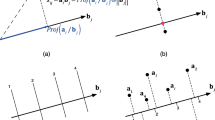Abstract
Prior to a three-way component analysis of a three-way data set, it is customary to preprocess the data by centering and/or rescaling them. Harshman and Lundy (1984) considered that three-way data actually consist of a three-way model part, which in fact pertains to ratio scale measurements, as well as additive “offset” terms that turn the ratio scale measurements into interval scale measurements. They mentioned that such offset terms might be estimated by incorporating additional components in the model, but discarded this idea in favor of an approach to remove such terms from the model by means of centering. Then estimates for the three-way component model parameters are obtained by analyzing the centered data. In the present paper, the possibility of actually estimating the offset terms is taken up again. First, it is mentioned in which cases such offset terms can be estimated uniquely. Next, procedures are offered for estimating model parameters and offset parameters simultaneously, as well as successively (i.e., providing offset term estimates after the three-way model parameters have been estimated in the traditional way on the basis of the centered data). These procedures are provided for both the CANDECOMP/PARAFAC model and the Tucker3 model extended with offset terms. The successive and the simultaneous approaches for estimating model and offset parameters have been compared on the basis of simulated data. It was found that both procedures perform well when the fitted model captures at least all offset terms actually underlying the data. The simultaneous procedures performed slightly better than the successive procedures. If fewer offset terms are fitted than there are underlying the model, the results are considerably poorer, but in these cases the successive procedures performed better than the simultaneous ones. All in all, it can be concluded that the traditional approach for estimating model parameters can hardly be improved upon, and that offset terms can sufficiently well be estimated by the proposed successive approach, which is a simple extension of the traditional approach.
Similar content being viewed by others
References
Fienberg, S.E.,& Gilbert, J.P. (1970). The geometry of a two by two contingency table. Journal of the American Statistical Association, 65, 694–701.
Haberman, S.J. (1995). Book review of “Statistical applications using fuzzy sets,” by K.G. Manton, M.A. Woodbury,& L.S. Corder. Journal of the American Statistical Association, XX, 1131–1133.
Hilbert, D.,& Cohn-Vossen, S. (1952). Geometry and the imagination. New York: Chelsea.
Holland, P.W. (1990). On the sampling theory foundations of item response theory models. Psychometrika, 55(4), 577–601.
Holland, P.W.,& Rosenbaum, P.R. (1986). Conditional association and unidimensionality in monotone latent variable models. Annals of Statistics, 14, 1523–1543.
Lazarsfeld, P.F.,& Henry, N.W. (1968). Latent structure analysis. Boston: Houghton Mifflin.
Manton, K.G., Woodbury, M.A.,& Tolley, H.D. (1994). Statistical applications using fuzzy sets. New York: Wiley.
Marini, M.M., Li, X.,& Fan, P.L. (1996). Characterizing latent structure: Factor analytic and Grade of Membership models. Sociological Methodology, 26, 133–164.
Potthoff, R.F., Manton, K.G.,& Woodbury, M.A. (2000). Dirichlet generalizations of latent-class models. Journal of Classification, 17(2), 315–353.
Prochaska, J.O., DiClemente, C.C.,& Norcross, J.C. (1992). In search of how people change: Applications to addictive behaviors. Americal Psychologist, 47, 1102–1114.
Ramsay, J.O. (1996). A geometrical approach to item response theory. Behav-iormetrika, 23, 3–17.
Woodbury, M.A., Manton, K.G.,& Tolley, H.D. (1997). Convex models of high dimensional discrete data. Annals of the Institute of Statistical Mathematics, 49, 371–393.
Author information
Authors and Affiliations
Corresponding author
Additional information
The author is obliged to Jos M.F. ten Berge and Marieke Timmerman for helpful comments on an earlier version of this paper. The author is obliged to Iven van Mechelen for making available the data set used in Section 6.
Rights and permissions
About this article
Cite this article
Kiers, H.A.L. Properties of and Algorithms for Fitting Three-Way Component Models with Offset Terms. Psychometrika 71, 231–256 (2006). https://doi.org/10.1007/s11336-001-0953-x
Received:
Accepted:
Published:
Issue Date:
DOI: https://doi.org/10.1007/s11336-001-0953-x




